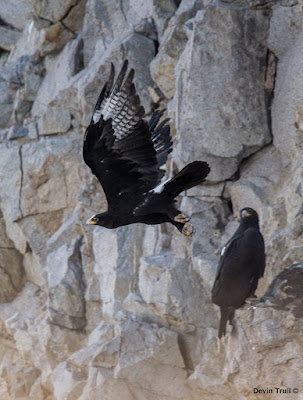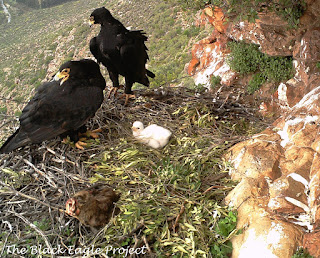My first few weeks going solo!
Here I am, sitting behind my desk. Locked in my 15m2
hut with the rain pouring down on my roof and the wind desperately trying to
get in. I can hear it knocking but I am not answering. With only Jack Johnson
singing his songs. Can´t you see that it´s just raining, ain´t no need to go
outside. After two and a half weeks of solo trips I have felt snow, rain,
clouds and have seen a lot of rainbows, sun and, of course, Black eagles. And
lots of mountains with beautiful views and impressive rock formations, formed
by wind, water and frost.
In my days in the Spanish Pyrenees I read somewhere.
Happiness is only real when shared. Well, that doesn’t count for me. “My”
eagles give me so many air shows and joyful moments (more on this later). And
the views here!!.. From certain spots you can see for many miles (hard to
estimate how far). These views give me goose bumps. I realize what I miss in
the Netherlands. And not to forget the rainbows. Every time I try to approach
them to look for the pot of gold they “ jump” to the next mountain. But one
day. I love it!!
During my last 3 weeks of fieldwork, not to forget that I am
actually working here, I have visited 16 nests in 7 days in the Sandveld. In
this area, I drive from one nest to the other to check their stage of breeding.
At this stage I hope to find them incubating. Some of them have started and
others look promising and spend a lot of time around or on the nest. The pairs that
are incubating spend much time on the nest and regularly swap. In the
Cederberg, on the other hand, I have to hike for hours to the nests where
access is much more difficult. Here they have nests in more remote places and I
spend a lot of time hiking to a good spot to set up my telescope and start my
observations. Here I have visited 12 nests so far. Like the Sandveld, here the
first pairs have initiated incubation. During my hikes I am thrilled by the
views and rock surrounding me. I force myself to stop every now and then to
“feel” the mountains, or to admire the baboons which let me know of their
presence by their impressive barking. They don’t seem to be impressed by my
barks. Luckily I have 5 months to impress them. Or klipspringers which are
checking me out from a rock and react to my whistles by facing me directly.
Most of the times they are in groups of three. After a while they move on and
hop up the rocks with the greatest ease. Also the sightings of Rock Hyrax or Dassies
become more common. Sunbathing on rocks they make their alarm calls. I think
there are not many animals living in the Cederberg which I see before they see
me.
But the Cederberg Mountains bring me strong winds, snow and
low temperatures as well. And the winter hasn’t even started yet. I am curious
what the real winter has to offer. I have learned that bad weather doesn’t
exist. But bad clothing does. Thus a good preparation for a cold day is
important because three hours of not moving with the wind in the face with a
vibrating telescope is tiring. A cloud that comes by and blocks my view on the
nest is most frustrating and leaves me cold. And the rain filling the rivers
which influence my thoughts of whether my bakkie can get through. But the
advice I got from Dawie was. “You just try and learn by experience when the
waterlevel is too high. This means that I just give it a go until I get stuck.
Why not? We’ll see where or when the ship beaches. So far I haven’t had any
problems.
Yesterday I had my first sightings
of humans in the field. The first pair consisted of two males and the other a
male and female. Both pairs didn’t show any signs of incubation. And both were
far outside of their territory, but I did not feel threatened. After my two
weeks in the Cederberg I have taken a look at my data on primate abundance. My
preliminary results suggest that the most abundant primate is the Chacma Baboon
(Papio ursinus) followed by humans (Homo sapiens). I have to be cautious
because I don’t have any statistical results to support these thoughts. First I
have to collect more data to confirm my suggestions (More on this later) .
And the Eagles. The Verreaux’s Eagle or Black Eagle. With
their ginormous wingspan of 2 meters. A flying door. Bigger than my wingspan.
The one moment they are checking out part of their territory from a perch or
their nest. The next they are in a thermal with warm rising air to gain height
without spending energy. The ease with which they glide through the air.
Jealous? Yes! And they probably see better than me even without a telescope.
Magical. I want to know how their eyes work. I feel fortunate to spend my time
watching these powerful raptors in this wonderful place.
~ Steven Karel Bekker






Comments
Post a Comment